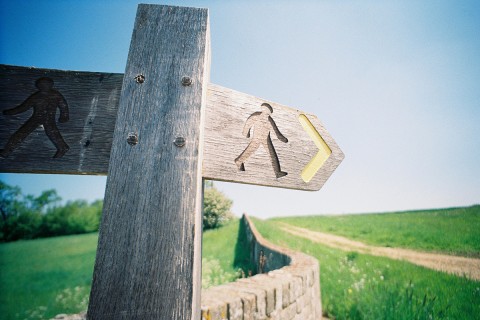Ways to walk
There’s something sacred in choosing to love the world at the speed of walking.

There are more than 200 references to walking in the Bible. Some have to do with physical mobility (“take up your bed and walk”). Many are metaphorical, like Micah’s famous dictum that ends with the phrase “walk humbly with your God.” There is also much talk of paths—ancient paths and slippery paths, paths of the wicked and of the upright, crooked paths and straight ones. The earliest Christians were called people who belonged to the Way, which suggests that discipleship from the beginning was a collective movement, with fellow travelers bound to each other in mutual care and affection. Certain strands of modern Protestantism would come to promote a more private spiritual project, posing questions like, “How is your walk with Jesus?”
As summer comes to a close, these bits of knowledge are on my mind. In recent months I found myself walking more than I ever have in my life. I walked for the benefits to my physical well-being. (I ran a good bit, too, but that is a different thing, with other associations to the Christian life.) I walked to relieve mental and emotional stress—to work some things out in my head and heart. And I walked to transport myself from hotel, to train, to hospital, and back again many times while my son was ill for several days in a faraway city.
Read our latest issue or browse back issues.
I don’t think my experiences of walking were at all exceptional. From the ancient peripatetic philosophers to Bashō, Rousseau, Thoreau, and—in our own time—Rebecca Solnit, human beings have long reflected on the deeply human action of bipedal motion. But, as with most things, when it’s your own experience it feels singular and revelatory.
The headspace one can free up as a regular walker makes possible epiphanies both prosaic and powerful. This summer I was reminded of an essay by the humorist David Sedaris in which he chronicles his obsession with his Fitbit and the self-imposed pressure to continually increase one’s daily step count. I’ll say here only that the temptation is real. But freedom from our devices is also a gift of mindful walking. We live so much of our lives in virtual spaces, interacting—even with those in close physical proximity to us—across digital platforms that are simultaneously everywhere and nowhere. But when we walk, we traverse geography at scale—moving through real time and real space with our real bodies. If the phone is pocketed and ignored, it is possible even to perceive differently, to engage all of the senses, to be aware of one’s body and the parallel rhythms of walking and breathing, step-taking and heart-beating, moving with intention and thinking with precision. In Solnit’s enchanting book Wanderlust, she quotes someone who says that in the experience of walking, “you can’t escape yourself.”
There are also cultural assumptions and practices about walking that reveal themselves. A guy walking confidently down the street is a man on a mission; a woman doing the same is subject to moral scrutiny, her walking often perceived more as performance than as transport. Walking as workout is clearly not the same as walking while homeless, and the privilege some of us have can make us unduly romantic and embarrassingly unaware.
In many religious traditions, pilgrimage is a form of walking that holds together the spiritual and the material, the journey and the arrival. Historically, pilgrims were not physically fit but often frail, walking great distances to reach healing wells and holy relics that would confer a blessing and restore well-being. Then and now, to make a pilgrimage is to walk not only in time and space but in a story. The hajj, for instance, highlights the significance of Abraham (Ibrahim) for Islam, and Muslim pilgrims from around the world enact ritualized walking in the city of Mecca, dressed identically in simple white clothing meant to conceal wealth and social status. The story of St. James the apostle’s evangelizing work in Spain anchors the Santiago de Compostela, also known as the Camino (“the Way”). Most who walk this 500-mile trek attest to Thomas Merton’s insight that “the geographical pilgrimage is the symbolic acting out of an inner journey.”
Walking the Camino may be on my bucket list, but every day that I choose to walk mindfully—in my neighborhood, on my campus, on the streets of unfamiliar cities—is an opportunity to despiritualize geography: to be attentive to the spaces, places, people, creatures on the path in front of me and alongside me. We are all of us fellow pilgrims on this journey, bearing unseen burdens, looking for healing and holiness, even if we cannot fully name that longing. There is something sacred in this: choosing to love the world at the speed of walking and to recognize the shared, if unspoken, vulnerabilities of all whom we meet. Doesn’t “walk humbly with your God” mean at least that?
I couldn’t write this column without walking it into being, so to speak. There are “surprises, liberations, and clarifications,” as Solnit puts it, in rising from my chair, closing the laptop, and setting forth on foot to experience walking’s peculiar utility for thinking. It’s a privilege, I know, and I try not to take it for granted. I commend it to you, dear reader, and wish you well on your own journey.
This article was edited on September 10, 2021.






